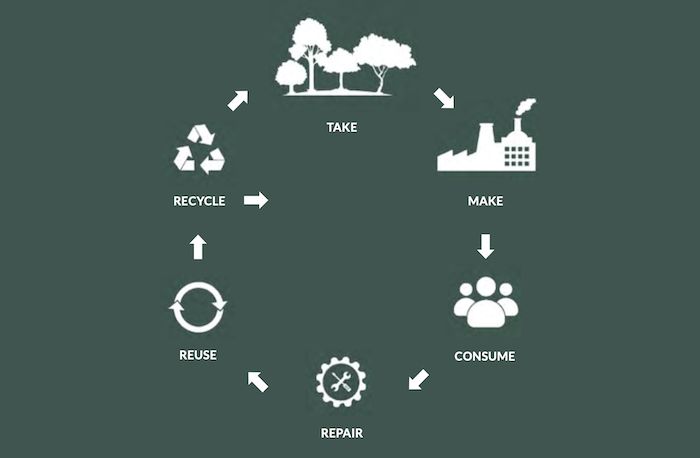What is Circular Design?

December 26, 2022
To understand the circular future we’re moving towards, let’s first take a quick look at our current ‘linear’ model. We live in a world in which the economic system follows ‘take-make-waste’ logic. Our current ‘linear economy’ extracts finite resources to make products that are used – largely not to their full potential – and then thrown away, generating waste and pollution. And then we churn out yet more new chairs, tables and lamps.
Meantime, climate change and socio-economic inequalities confirm that the linear economic model isn’t working for either the environment, people or businesses. So how can we transform this throwaway paradigm into a just, regenerative and sustainable system? We believe the answer lies in the ‘circular economy.’ This economic system incorporates nature’s cyclical models, where nothing is lost, and everything flows and persists as a valuable resource to living beings and ecosystems. In short, the circular economy is based on three fundamental principles: eliminate waste and pollution, keep products and materials in use and regenerate natural ecosystems.
Along with these three principles, a thriving circular economy requires prioritizing social inclusion, equity, fairness and the health and well-being of workers, consumers, and local communities.
At the heart of the circular economy is design, deployed up front as a powerful tool to determine how something is manufactured, used and ultimately discarded. Design choices – according to the Ellen MacArthur Foundation – are responsible for 80% of the environmental impact of products, systems and services.
The Circular Design Glossary features more than 40 key concepts of this way of thinking. Here are a few:
Dematerialization: Dematerialization is a strategy for creating products and services with the minimum possible usage of new physical material. Approaches include reducing use of extracted materials such as ores, minerals, and oil; increasing efficiency in the use of materials; improving recycling and use of residual materials; and shifting our focus from ‘products’ to ‘services’ – such as offering furniture for rent instead of purchase.
Design for Disassembly: Design for Disassembly facilitates transportability and future changes in use by making it as easy for
the end user to dismantle a product as it is to assemble it. Carefully designed products can be disassembled in part or completely for reconfiguration or ease in moving. Design for disassembly ensures material recovery, value retention and meaningful next use.
Embedded Impacts: Embedded Impacts describe the cumulative consequences of making, distributing, using and disposing of a product. These impacts can be positive or negative and reflect a wide range of environmental and social contributors. Some contributors are literal while others are less obvious but equally essential. Examples include the effects and consequences of resource extraction, production methods, product durability, employee health and supply chain policies.
Regenerative Design: Regenerative Design focuses on restoring, renewing and revitalizing depleted ecosystems and communities. This approach seeks not only to lessen harm but rather to put design, materials and products to work as positive forces with the capacity to repair natural and human systems. To operationalize regenerative design, companies must understand the impact of their products and processes on interconnected places and people.
Traceability: Traceability allows a company or consumer to track the movement of a material along the supply chain from its origin through to its sale – providing a window of accountability into environmental sustainability practices, labor conditions, manufacturing facilities and other factors. While it is more challenging to track globalized supply chains, recent advances in track-and-trace technologies support companies by facilitating supply chain transparency. This makes it possible for producers to track the whereabouts of sold products in support of take-back programs, extended producer responsibility and other circular practices.
—The Circular Design Glossary was produced by mebl and the Sustainable Furnishings Council. To download a copy of the full document, click here.
More News
April 26, 2024 | Business, Trends & Inspirations
Personalization Is Defining Today’s Luxury Projects
April 26, 2024 | Business
PIRCH Permanently Shuts Down, Files for Bankruptcy
April 25, 2024 | Awards & Events
2024 Coverings Installation & Design Award Winners Announced
April 24, 2024 | People
Oatey Announces New COO and CCO
April 23, 2024 | Trends & Inspirations
Sustainability Report: More Education Needed for Green K&B Design
April 2, 2024 | Sponsored
Whirlpool Corp. Brings Purposeful Innovation Home